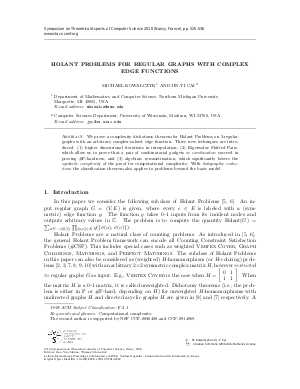Holant Problems for Regular Graphs with Complex Edge Functions
Authors Michael Kowalczyk, Jin-Yi Cai
-
Part of:
Volume:
27th International Symposium on Theoretical Aspects of Computer Science (STACS 2010)
Part of: Series: Leibniz International Proceedings in Informatics (LIPIcs)
Part of: Conference: Symposium on Theoretical Aspects of Computer Science (STACS) - License:
 Creative Commons Attribution-NoDerivs 3.0 Unported license
Creative Commons Attribution-NoDerivs 3.0 Unported license
- Publication Date: 2010-03-09
File

PDF
LIPIcs.STACS.2010.2482.pdf
- Filesize: 330 kB
- 12 pages
Document Identifiers
Subject Classification
Keywords
- Computational complexity
Metrics
- Access Statistics
-
Total Accesses (updated on a weekly basis)
0Document
0Metadata
Abstract
We prove a complexity dichotomy theorem for Holant Problems on $3$-regular graphs with an arbitrary complex-valued edge function. Three new techniques are introduced: (1) higher dimensional iterations in interpolation; (2) Eigenvalue Shifted Pairs, which allow us to prove that a pair of combinatorial gadgets \emph{in combination} succeed in proving \#P-hardness; and (3) algebraic symmetrization, which significantly lowers the \emph{symbolic complexity} of the proof for computational complexity. With \emph{holographic reductions} the classification theorem also applies to problems beyond the basic model.
Cite As Get BibTex
Michael Kowalczyk and Jin-Yi Cai. Holant Problems for Regular Graphs with Complex Edge Functions. In 27th International Symposium on Theoretical Aspects of Computer Science. Leibniz International Proceedings in Informatics (LIPIcs), Volume 5, pp. 525-536, Schloss Dagstuhl – Leibniz-Zentrum für Informatik (2010)
https://doi.org/10.4230/LIPIcs.STACS.2010.2482
BibTex
@InProceedings{kowalczyk_et_al:LIPIcs.STACS.2010.2482,
author = {Kowalczyk, Michael and Cai, Jin-Yi},
title = {{Holant Problems for Regular Graphs with Complex Edge Functions}},
booktitle = {27th International Symposium on Theoretical Aspects of Computer Science},
pages = {525--536},
series = {Leibniz International Proceedings in Informatics (LIPIcs)},
ISBN = {978-3-939897-16-3},
ISSN = {1868-8969},
year = {2010},
volume = {5},
editor = {Marion, Jean-Yves and Schwentick, Thomas},
publisher = {Schloss Dagstuhl -- Leibniz-Zentrum f{\"u}r Informatik},
address = {Dagstuhl, Germany},
URL = {https://drops.dagstuhl.de/entities/document/10.4230/LIPIcs.STACS.2010.2482},
URN = {urn:nbn:de:0030-drops-24826},
doi = {10.4230/LIPIcs.STACS.2010.2482},
annote = {Keywords: Computational complexity}
}
